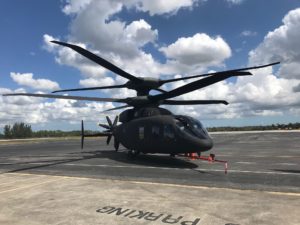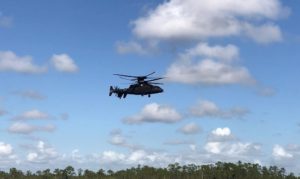WEST PALM BEACH, Fla.—Sikorsky [LMT] and Boeing’s [BA] SB-1 Defiant helicopter offering for the Army’s Future Long Range Assault Aircraft (FLRAA) program has gathered 11 flight test hours to date, in addition to thousands of hours from component testing and simulation data, officials told reporters ahead of the platform’s first public flight on Thursday.
With FLRAA headed toward a downselect decision in March for the program’s competitive demonstration phase, company officials said the SB-1 Defiant has now been flying at least once a week since the beginning of the year.

“I know everybody wants to look at aircraft flying and those hours and everything, but the data that’s generated from this very robust testing regime that Sikorsky and Boeing are going through generates exactly the data that the Army really is looking for. It’s important to really see the level of maturity on the different components as well as for this aircraft,” Randy Rotte, Boeing’s business development director for Future Vertical Lift programs, told reporters here.
FLRAA is the program to find a UH-60 Black Hawk replacement with the Army recently concluding the Joint Multi-Role Technology Demonstrator program, intended to inform final FLRAA requirements and which featured SB-1 Defiant and Bell’s [TXT] V-280 tiltrotor as the two participants.
While SB-1 Defiant has reached 11 hours in the air across 13 flights over the last year, Bell’s V-280 Valor tiltrotor aircraft has flown over 160 hours over the last two years.
Army Secretary Ryan McCarthy has previously acknowledged the disparity in flight hours for two of the main offerings vying for FLRAA, reiterating that the competition will move forward in line with the service’s continued modernization push (Defense Daily, Jan. 10).
Sikorsky and Boeing said they have utilized a series of ground tests along with rigorous component testing on the Propulsion Systems Test Bed at the West Palm Beach, Florida, facility, which gathers critical data for SB-1 Defiant without having to take the platform up into the air.
“If all we had was Defiant and we went out and we had to fly this aircraft every day to be able to look at the data on different components, that’s kind of a limitation. The PSTB that is the exact same drivetrain, the propeller, the blades, everything’s the same. So we’re able to run in different load configurations to produce data on that without having to fly the aircraft. So they complement each other,” said Bill Fell, the senior test pilot for Defiant.
During Thursday’s test flight, which was attended by McCarthy, top Army aviation officials and Sen. Tammy Duckworth (D-Ill.), the SB-1 Defiant flew at speeds up to 140 knots.

“I am personally committed to maintaining strict oversight of the Army’s Future Vertical Lift program, but also for advocating to improve it as a member of the Senate Armed Services Committee. I think this capability is crucial for nation’s future warfighting capability,” Duckworth said following the flight demonstration.
Prior to the test, Fell noted that he has flown Defiant up to 130 knots using only a portion of the aircraft’s full power with plans to “very rapidly expand the envelope from there.”
“When we’re flying at 130 knots in this machine, we’re using less than 20 percent of the propeller power and less than 30 percent of the engine power. So expect a lot more,” Fell said.
Dan Schultz, president of Sikorsky, compared Defiant to a fifth-generation aircraft and added that the two companies’ have “conquered the challenge of retreating blade stall” that will have the aircraft on the path to reach over 200 knots while maintaining maneuverability
“Both Boeing and Lockheed have spent over $500 million, and we’re continuing to spend as we develop this,” Schultz said. “Without Boeing we wouldn’t be here today, because their engineering brings a whole different capability than we have. To bring two of the best aerospace companies together it’s just powerful.”